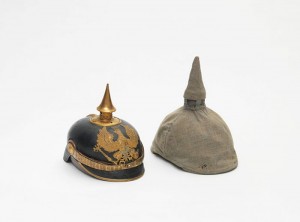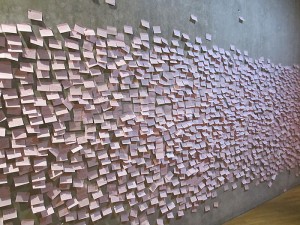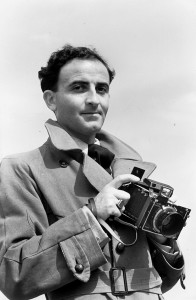“Our inclination to hopefulness and expectations of a final victory are unabated and yet the long wait does at times begin to worry us.”
The cultural and literary historian Ludwig Geiger, son of the famous reformist rabbi Abraham Geiger, penned these lines to a friend on 5 December 1914. The “long wait” which had started to trouble him four months after the Great War broke out, ultimately dragged on for almost four more years and yet failed to bring the victory so yearned for. Soldiers at the time could barely imagine what massive destruction this first modern war would wreak. The paltry equipment with which they set off for the front is proof enough of that.

Dr Max Litthauer’s Pickelhaube (spiked helmet) with camouflage covering, 1914–1918. Donated by Bart Ullstein © Jewish Museum Berlin, photo: Jens Ziehe.
On display both in the exhibition “The First World War in Jewish Memory” at the Jewish Museum Berlin and in the special exhibition “1914–1918. The First World War” at the German Historical Museum (DHM) are Pickelhauben, spiked helmets made of hardened (boiled) leather and with a cloth covering for camouflage—for a metal spike protruding above a trench and catching the sunlight made its wearer a sitting target. On my guided tours of the two exhibitions, I take the Pickelhaube as an opportunity to talk about how much this war differed from previous ones as well as how ill-prepared the military was, initially, for the new weaponry deployed.
→ continue reading

A wall full of questions at the exhibition “The whole truth” © Jewish Museum Berlin, photo: Thomas Valentin Harb
The special exhibition entitled “The whole truth… everything you always wanted to know about Jews” ended more than a year ago. Besides the animated discussions and empty display cases, there are thousands of pink post-it notes left over. Visitors stuck their questions, commentary, and impressions on a concrete wall after they went through the exhibition and left the museum. A kind of analog “facebook” arose out of these contributions, above and beyond the contents of the exhibition itself. Visitors commented on each others’ notes and raised new questions: on the history of Jews in Germany, on the conflict in the Middle East, on the relationship between Christianity and Judaism, and – again and again – on the subject of circumcision. At this point, the Jewish Museum Berlin had already decided to dedicate not just another blog post to the contentious topic (as part of the series “Question of the month”), but an entire new exhibition.
We recall: → continue reading
108 years ago, on 29 September 1906, in the Neukölln neighborhood of Berlin, the photographer Herbert Sonnenfeld caught his first glimpse of the light of the world.
His photographs constitute one of the largest and most important portfolios in the Jewish Museum Berlin’s photographic archive. The Sonnenfeld collection consists of some 3000 negatives taken between 1933 and 1938. Along with Abraham Pisarek and Arno Kikoler, Sonnenfeld is one of the few Jewish photographers to document Jewish life in and around Berlin in the 1930s, passing down to us today an unparalleled photographic witness to that period.

Herbert Sonnenfeld, photograph by Leni Sonnenfeld, Berlin ca. 1935
© Jewish Museum Berlin, purchased with funds provided by Stiftung DKLB
Herbert Sonnenfeld first worked as an insurance employee before being laid off as a result of the Nazi regime’s anti-Semitic measures. He came to photography circuitously and was an autodidact. Following a trip to Palestine in 1933, his wife Leni approached various Jewish newspapers and offered them her husband’s pictures. They were enthusiastic, promptly bought up the prints, and asked for more. Thus began Sonnenfeld’s career as a press photographer.
→ continue reading


